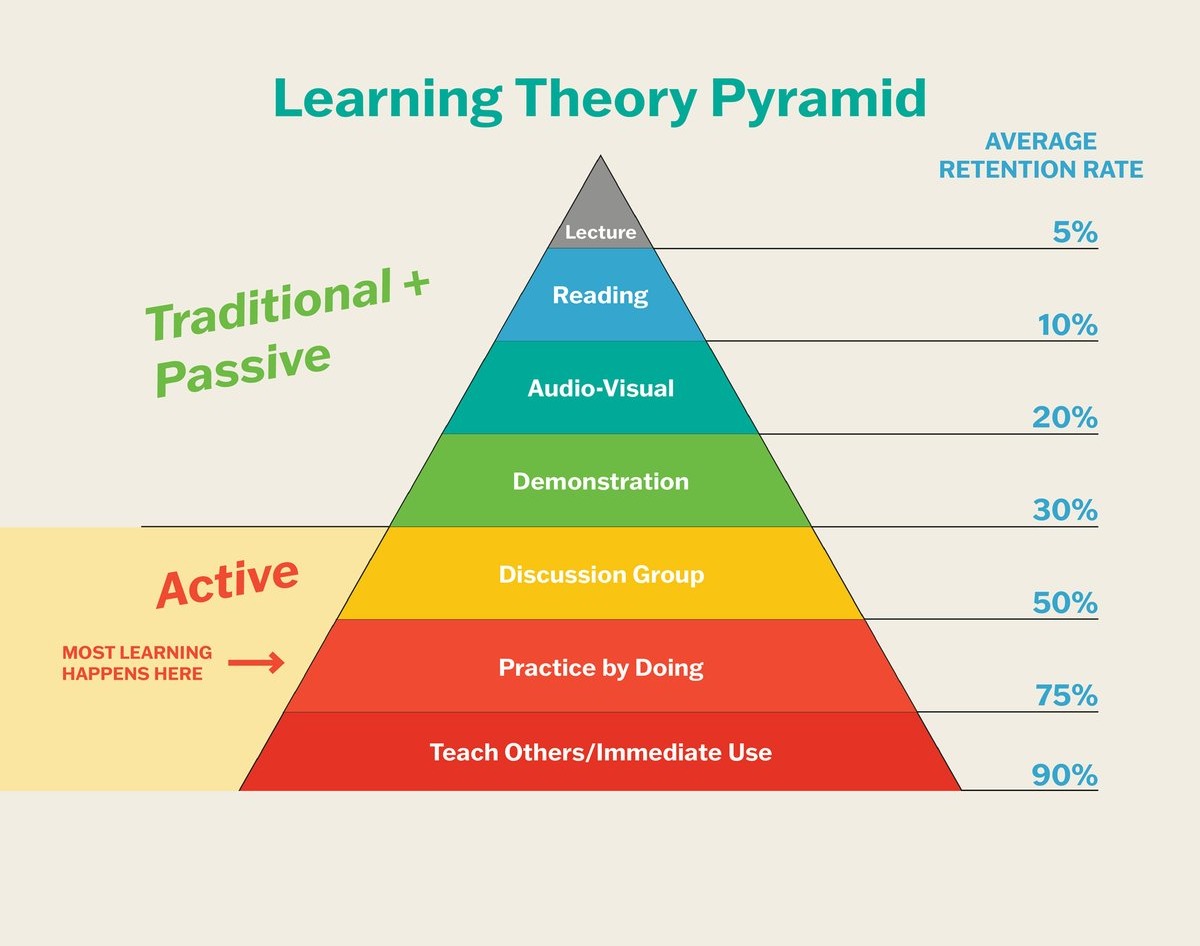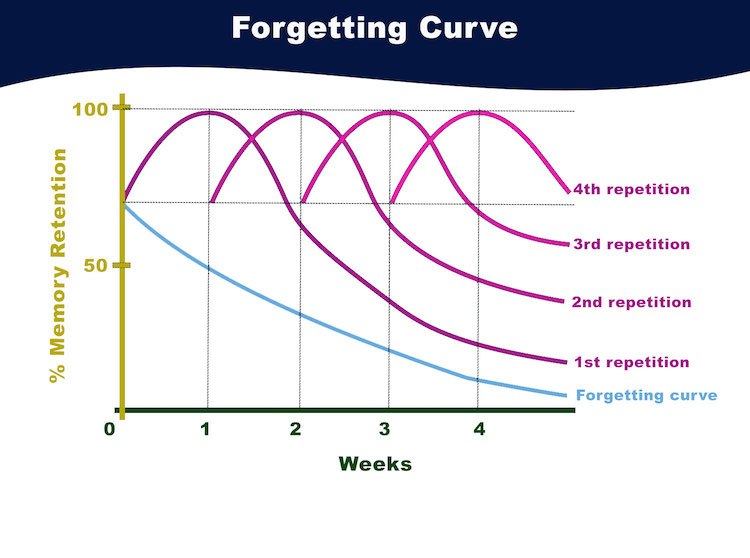In today’s information-rich era, understanding how to learn efficiently and effectively is becoming increasingly crucial and core to our approach at Axon Park. The field of learning science, which blends insights from psychology, cognitive science, and education, has made significant strides in uncovering the strategies that lead to optimal learning. Emphasizing an evidence-based approach, these insights offer more than just advice—they provide empirically-backed strategies that are proven to enhance learning outcomes. This article delves into these evidence-based learning techniques, spotlighting their scientific underpinnings, practical applications, and how they can be harnessed to create an enriching learning experience. With a focus on understanding and applying these research-backed strategies, learners can not only improve their learning skills but also develop the ability to adapt in an ever-evolving educational landscape.
In this article, we explore empirically-supported learning strategies, examining their potential to enrich learning within an AI-powered immersive and interactive learning environment.
Table of Contents
- The Learning Pyramid
- Understanding Effective Learning Techniques
- Harnessing Practice Testing for Enhanced Learning
- Leveraging Distributed Practice for Sustained Learning
- Implementing Interleaved Practice in Learning Platforms
- Gamification of Learning
- Expectation to Teach as a Learning Strategy
- Building on Existing Knowledge
- Consideration of Diverse Learning Styles and Accessibility
- Assessments and Measuring Progress
- Role of Teachers and Educators
- Incorporating Exercise into the Learning Process
- Changing the Way You Learn
- Conclusion
The Learning Pyramid
The Learning Pyramid, often associated with the National Training Laboratory, is a well-known concept suggesting that learners retain varying amounts of information depending on their level of engagement in the learning activity. This model promotes the idea that active learning methods—such as teaching others, practicing, or discussing—are more effective for retention than passive activities, aligning with the broad principles of active learning and the constructivist theory of learning. Furthermore, it underscores the value of multimodal learning, promoting the use of various senses to cater to diverse learning modalities.

Credit: VSA Future
However, the Learning Pyramid, as a conceptual framework, has some limitations that should be acknowledged. One notable weakness is the lack of consensus regarding the specific retention percentages assigned to each learning method. Another drawback of the Learning Pyramid lies in its tendency to oversimplify the learning process by implying a linear progression of effectiveness without accounting for various influential factors. It fails to consider the significance of factors such as prior knowledge, individual interest, and the learning context. These elements can significantly impact the effectiveness of different learning modalities. On top of this, factors such as repeated practice, interleaving of topics, and spaced repetition play critical roles in enhancing learning outcomes, yet they are not explicitly incorporated into the pyramid.
Therefore, while the Learning Pyramid can serve as a useful starting point and a general guide, the development of effective learning strategies or platforms should be rooted in well-supported research findings from the learning sciences. The essence of the pyramid, emphasizing the effectiveness of active learning, should still inform our approach, however, to design more nuanced and impactful implementations, we must draw upon a more comprehensive understanding of learning methodologies and incorporate additional evidence-based practices. To this end, let’s dive deep into the world of learning science and explore how these techniques can be holistically applied within the context of an immersive and interactive learning platform.
Understanding Effective Learning Techniques
To make sense of the complexity of human learning, it’s vital to understand the effectiveness of various learning techniques. In a comprehensive meta-analysis, learning techniques were systematically evaluated and categorized into high, moderate, and low support categories based on the robustness of their supporting evidence.
Learning techniques vary in effectiveness. Practice Testing and Distributed Practice earn high support, actively engaging learners for improved recall. Moderately effective techniques, like Elaborative Interrogation, Self-Explanation, and Interleaved Practice, generate explanations and mix problem types, serving as useful learning adjuncts. Techniques like Summarization, Highlighting/Underlining, and Re-reading, despite common use, exhibit lesser efficacy.
Moreover, research underscores that learning is most effective when certain conditions are met, such as the presence of a clear structure supporting learning, setting and communicating high expectations, learners acknowledging and leveraging their prior learning, fostering an active learning process, ample time for practice, collaboration among students and between students and staff, and the provision of constructive feedback.
Harnessing Practice Testing for Enhanced Learning
Practice testing, a crown-jewel technique that involves self-testing or taking practice tests, plays a crucial role in enhancing learning outcomes. This strategy benefits from the concept of active recall, where learners actively retrieve information from memory, significantly enhancing memory retention compared to passive review.
Research has consistently shown the effectiveness of practice testing in a variety of learning contexts. Studies comparing students who employ practice testing with those who do not show that the former group performs significantly better on final tests. This occurs even when learners spend an equal amount of time studying, underscoring the value of testing as a tool for enhancing memory, not just evaluating it.
When designing an interactive learning platform, the inclusion of practice testing can serve multiple purposes. First, it offers students immediate feedback on their learning progress, allowing them to identify gaps in their understanding and areas requiring additional focus. Secondly, it promotes active engagement with the material, enhancing long-term memory retention. Finally, practice testing can alleviate test anxiety, as frequent exposure to test-like situations can help learners become more comfortable with evaluations. This is now possible thanks to powerful large language models like ChatGPT or LLaMA. The ability to engage in real-time practice with this level of precision is only now becoming possible.

Distributed practice
Leveraging Distributed Practice for Sustained Learning
Distributed practice, also known as spaced repetition, is another highly supported learning technique. This approach involves spreading out study activities over time, in contrast to massed or ‘crammed’ practice. The benefit of distributed practice comes from the “spacing effect,” a psychological principle suggesting that people learn more effectively when their study is spread out over time.
Numerous studies have demonstrated the superior efficacy of distributed practice in enhancing long-term memory retention. The benefit persists across different types of tasks, materials, and learners, making it a versatile and robust strategy for many learning contexts.
In the context of an immersive learning platform, distributed practice can be seamlessly integrated into the learning design. For instance, an intelligent algorithm can schedule review sessions for specific topics at increasing intervals, ensuring that learners revisit material just as they are about to forget it. This approach not only optimizes the learning process but also fosters sustainable learning habits that promote lifelong learning. Besides, as learners engage with the material multiple times, they have more opportunities to connect new knowledge with existing knowledge, enhancing their understanding and creating a more comprehensive knowledge network. Leveraging the capabilities of AI, we can analyze a learner’s engagement data to identify the optimal times for reintroducing topics, thereby ensuring a more effective reinforcement of knowledge and facilitating deeper, more durable learning.
Implementing Interleaved Practice in Learning Platforms
Interleaved practice, a technique of mixing different types of problems or subjects within one study session, has shown promise in boosting learning outcomes. Unlike blocked learning, where one topic is mastered before moving onto the next, interleaved practice facilitates stronger comprehension and transfer of skills.
A meta-analysis of numerous studies illustrated the impact of interleaved learning, with results suggesting an overall moderate improvement in learning outcomes. The benefits varied based on the type of learning materials, proving particularly effective with visual content and mathematical tasks. However, its efficacy with expository texts and words was less clear, indicating that the implementation of interleaved practice should be considered carefully based on the subject matter.
In the context of an interactive learning platform, the judicious application of interleaved practice can optimize learning, providing learners a more effective way to internalize and generalize knowledge. It’s an evidence-based technique that demonstrates the potential of varied practice to enhance the learning experience. Integrating AI into this approach, we can dynamically adjust the interleaving of topics based on learner performance and engagement, effectively personalizing the learning pathway for optimized outcomes.

Gamification of Learning
Gamification, the incorporation of game design elements in non-gaming contexts, is increasingly recognized as an influential tool in education. Gamified elements, such as point scoring, competition, achievement badges, leaderboards, and progress-tracking, can stimulate student engagement, foster healthy competition, and offer a sense of accomplishment. By making learning more interactive and rewarding, gamification enhances students’ motivation and immersion in the educational content.
A robust example of gamification’s educational potency comes from a study conducted at the School of Electrical and Computer Engineering of the National Technical University of Athens. Using a web-based gamified application called “Horses for Courses” for teaching statistics, the researchers implemented a challenge-based approach. This strategy led to a remarkable 89.45% increase in student performance, compared to traditional lecture-based teaching methods. This result underscores gamification’s potential in revolutionizing education, transforming it into an engaging, effective, and fun endeavor.
Integrating gamification into an immersive and interactive learning platform enhances learner engagement and effectiveness. The platform can utilize game mechanics such as points, badges, leaderboards, and achievement levels, transforming the learning process into a dynamic experience. Features such as earning rewards for completing modules or solving problem-based challenges can stimulate interest and improve recall. Furthermore, progress tracking and achievement levels provide tangible milestones, fostering motivation and a sense of accomplishment. By blending education with the motivational power of games, the platform caters to diverse learning styles and preferences, thus making learning an engaging, rewarding, and effective process. AI can further elevate the gamified learning experience by personalizing the challenge level, adapting reward mechanisms to individual learners, and providing real-time feedback, ensuring a more engaging, motivating, and ultimately successful learning journey for each user.
Expectation to Teach as a Learning Strategy
The ‘expectation to teach’ is a significant strategy that enhances learning outcomes. Studies indicate that learners preparing to teach others often exhibit better recall and organized knowledge compared to those just studying for a test. The anticipation of teaching prompts deeper information processing and links new material to existing knowledge, leading to improved comprehension and retention.
This strategy also has valuable implications for group learning. As students prepare to teach peers, they not only deepen their understanding but also hone collaborative and communication skills.
In an interactive learning platform, the ‘expectation to teach’ can be implemented by creating simulated teaching environments or tasks that require learners to prepare lessons on specific topics. Moreover, technology can facilitate this strategy through virtual classrooms, discussion forums, and collaborative projects. Hence, integrating the ‘expectation to teach’ enhances not only knowledge recall but also critical thinking and interpersonal skills, providing a more comprehensive education. With the incorporation of conversational AI, the learning platform can create a unique environment where students are encouraged to “teach” the AI, reinforcing their understanding and mastery of the subject matter through the act of explaining it back to the intelligent system.

Building on Existing Knowledge
The principle of building on existing knowledge, or ‘scaffolding,’ plays a crucial role in effective learning. Research, including a notable study involving 710 young adults, supports this concept. Those who learned new information faster, connecting it with what they already knew, recalled more and relearned more rapidly. This demonstrates how learning forms an interconnected ‘web’ of knowledge, making recall easier and the overall learning process more effective.
This idea plays a significant role in designing an immersive learning platform. Before introducing new topics, the platform could activate prior knowledge through brief quizzes or activities. This prepares learners for new information and highlights connections between old and new knowledge. Adaptive learning technologies can also utilize this principle by adjusting the learning path based on the learner’s existing knowledge and skills. In summary, leveraging prior learning enhances learning outcomes, promotes deeper understanding, and creates a more personalized learning experience. Integrating AI into this process, algorithms can dynamically assess and adapt to a learner’s knowledge base, presenting new information in relation to what the learner already understands, thereby facilitating a more seamless and effective scaffolding of learning.
Consideration of Diverse Learning Styles and Accessibility
Designing a learning platform to cater to diverse learning styles may enhance user engagement and learning outcomes. Gardner’s theory of multiple intelligences posits that individuals differ in their preferred modes of learning, however the jury is out on the efficacy of this approach.
The concept of individual learning styles has been questioned by meta-analyses dating back to the 1970s, with consistent findings that there’s minimal empirical evidence to support tailoring instruction to an individual’s preferred style—a notion often termed a “neuromyth.” Rather than focusing on adapting to specific learning styles, current educational perspectives emphasize the importance of implementing a variety of teaching methods that encourage active learning. This broad approach ensures accessibility and engagement for all learners by providing diverse ways to interact with material, varied content representation, and multiple means to demonstrate understanding. Thus, an inclusive learning environment, rich in teaching methods and learning platform accessibility, holds greater educational value than adhering to contested learning styles.
Furthermore, universal design principles suggest that accessibility should be a fundamental consideration in any learning platform. This means designing a platform that is usable by people with the widest possible range of abilities, operating within the widest possible range of situations. For example, research published in the “Journal of Special Education Technology” revealed that screen readers and closed captioning significantly improved the learning experience for students with visual and hearing impairments, respectively. AI can play a transformative role in this context by intelligently adapting to individual learner’s needs, dynamically adjusting content presentation, and offering multiple methods for learners to engage with and demonstrate their understanding of the material, thereby enhancing the inclusivity and effectiveness of the learning platform.

Assessments and Measuring Progress
Assessment strategies and progress tracking are essential aspects of any effective learning platform. Formative assessments, or “assessments for learning,” provide feedback during the learning process, guiding adjustments in teaching and learning to improve student achievement. A meta-analysis demonstrated that formative assessments significantly enhance student achievement.
An examination of 252 scholarly papers published between 2012 and 2018 on the application of learning analytics in higher education yielded some insightful results. The study found only modest evidence that learning analytics improve student outcomes (9%) or support teaching and learning effectively (35%). Moreover, it highlighted that the broad-scale adoption of learning analytics has been minimal (6%), and ethical issues remain a concern (18%). Although learning analytics promise immense potential to enhance educational practice, their implementation has been limited thus far. However, with growing insights into student learning experiences based on learning analytics, it’s expected that their utilization will increase and evolve in the years to come.
In an interactive learning environment, tracking learner progress can be nuanced and comprehensive, encompassing elements like quizzes, self-evaluations, and advanced analytics capturing learner activity and involvement. The potential impact of these immersive platforms on learning outcomes is substantial, given their ability to gather in-depth data. The analytics derived from these data may, in turn, contribute significantly to enhancing learning experiences, transcending the limitations of traditional models. The implications include personalized learning journeys, improved curriculum structuring, and transformative improvements in learner outcomes. Leveraging AI, these platforms can provide real-time, intelligent assessments, and feedback, tailor the learning content based on learner performance, and predict future learning needs, thereby creating a more personalized, adaptive, and effective learning environment.
Role of Teachers and Educators
Even in an immersive and interactive learning platform, the role of teachers and educators remains paramount. In addition to facilitating learning and providing feedback, educators play an essential role in fostering a sense of community and offering emotional support.
Moreover, the use of learning platforms can augment traditional teaching strategies. For example, the flipped classroom model, where students review material at home and use class time for interactive activities, has shown promise. A meta-analysis published in “Educational Research Review” found that the flipped classroom model had a significant effect on student achievement and student satisfaction.
The development of an immersive, interactive learning platform should consider diverse learning styles and accessibility, incorporate effective assessment and progress tracking strategies, and recognize the critical role of teachers and educators. By doing so, the platform can provide a comprehensive, inclusive, and effective learning experience for all users. Harnessing the power of AI, the platform can assist educators by providing actionable insights about each learner’s progress and needs, facilitating personalized guidance, and enabling more efficient and impactful instruction, thereby enhancing the overall teaching and learning experience.
Incorporating Exercise into the Learning Process
The integration of physical activity into learning processes has also been shown to enhance cognitive function and memory recall, adding another dimension to evidence-based learning techniques. A compelling study demonstrates this connection, examining the effects of memorization during, after, and without physical exercise – specifically cycling.
The study found that participants memorizing while cycling showed superior recall performance compared to those memorizing after cycling or without any physical activity. This suggests that simultaneous exercise and learning could potentially boost recall abilities and, consequently, learning outcomes.
The implication for an interactive and immersive learning platform is significant. By integrating elements of physical activity into learning sessions, whether actual exercise or simulated experiences, we could potentially enhance the learning experience and improve outcomes. It highlights the importance of considering multiple factors and dimensions in our approach to learning and education. Utilizing AI, we could design interactive systems that suggest optimal moments for physical activity based on the learner’s performance and engagement data, promoting a balanced and efficient learning routine that incorporates both cognitive and physical elements for optimal results.
Changing the Way You Learn
The process of learning is not static. “Changing the Way You Learn” is a promising approach that emphasizes the fluid nature of the learning process. In traditional learning frameworks, repetition and rote learning often take precedence. However, innovative research from Johns Hopkins suggests that infusing variations into practice sessions can expedite skill mastery.
This principle is rooted in the concept of memory reconsolidation, a process wherein existing memories are not only recalled but also modified with new information. Particularly in the context of motor skills, this concept offers valuable insights. For instance, in learning to play an instrument, practicing the same piece repeatedly may reinforce fundamental techniques. But introducing subtle changes, such as adjusting tempo or adding complexity, can enhance the learning curve.
Applying this principle in the design of an immersive, interactive learning platform has enormous potential. Instead of merely repeating tasks, learners could encounter nuanced changes in each practice session. This could be slight alterations in the context of a problem, incremental increases in difficulty, or shifts in perspective. The platform can also include feedback mechanisms to help learners understand how their skills are evolving with the variations. By leveraging AI, these platforms can dynamically introduce appropriate variations in the learning material, monitor learner response, and adjust the level of complexity in real-time, thereby creating a truly personalized and effective learning experience that emphasizes the fluidity and adaptability of the learning process.
In Summary
The integration of evidence-based techniques into learning platforms is pivotal in enhancing learning efficiency and sustainability. These methods, derived from cognitive science, psychology, and education, provide a scientifically supported approach to optimize learning outcomes.
Key strategies, including active recall through practice testing, distributed and interleaved practices, the expectation to teach, and leveraging existing knowledge, contribute to a rich learning experience. Accompanied by the incorporation of physical exercise, gamification, and by acknowledging diverse teaching styles, these strategies advocate for a holistic learning approach.
Creating a next-gen learning platform goes beyond digitizing traditional methods—it’s about leveraging learning science to transform the educational experience with the new tools that push the boundaries of what has previously been possible. With these principles in mind, we can design platforms that promote lifelong learning and equip learners to thrive in an ever-evolving world. This is our mission and passion at Axon Park, and we’re committed to developing systems that build on the shoulders of giants to create solutions that are evidence-based and truly effective for both learners and educators.



